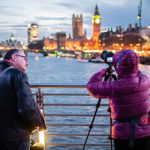A while back I visited the George Eastman Museum of Photography where there was an exhibition on travel photography. It was a great experience to see the world’s best photographs showcased in a two hour tour of the exhibition halls. After looking at most of the photos, I found an intangible element in almost all the photos. It’s the “story” behind the photo.

Photo by Ramnath Bhat.
We all have emotions within us, and a careful shot of a scene can make us laugh, cry, or even get angry. This is the magic of a photo that tells a story. When a person feels an emotion the person will hardly be able to forget the specific thing, process, or event that triggered the emotion, be it positive or negative feelings. The same holds true when a person sees a photograph. A photograph always tells us a story—actually there can be multiple stories associated with one photo. But it’s in the mind of the photographer to direct the minds of the viewers to a particular, strong, and appealing story. And if the photographer is not successful in this endeavor then the photograph loses its distinctiveness and falls under the average category.
This topic is closely linked to travel, street photography, and photo journalism, but it doesn’t have to be limited to only those fields. Actually everything that happens around us has some background story linked to it, unless you’re a computer geek sitting in front of computer and surfing the Internet for 23 hours a day. Even a photo of such a geek sitting amid gadgets and looking at the computer screen busily typing can make an excellent story-telling photo. Who knows, this might be the winner at the “Best Geek Photo” of the millennium contest. Of course, you will get “better” real life shots when you are out in a public place (street photography) or a tourist place (travel photography) or an event location (photo journalism).

Photo by Brett Kiger; ISO 200, f/8, 1/800 exposure.
So now you have an idea of what a story telling photo is and why it’s so important to make the viewers feel an emotion when they look at your photos.
Now let’s get to work. First of all, story telling in itself is very creative and it’s difficult to formulate any specific “techniques” to tell good stories. But definitely there’s a structure. The same holds true for photography. The next thing to keep in mind is if you are not satisfied with the photograph’s capability of imprinting a story in your mind, it probably won’t have any effect on any other viewer’s mind either.
As any other properties of storytelling, a photo should comprise of one or more of five elements:
- Mood
- Emotion
- Narrative
- Ideas
- Messages
Let’s elaborate on each of these characteristics one by one.
1. Mood
Mood can be achieved using correct background (objects or effects like blurring). The background should have a “relationship” with the subject in order to bring the mood. Even the objects can be inter-linked to build up the thought process of the viewer in a particular guided path.
2. Emotion
The emotion can be demonstrated through facial expressions of a person as well as activity being performed by the subject(s).

Photo by Thomas Hawk; ISO 6400, f/2, 1/100 exposure.
3. Narration
The narrative property in a photo comes to life when the viewer can easily visualize what happened “before” the shot was taken from what is happening in the photograph (similar to narrating a story to demonstrate the flow of events). This can be successfully demonstrated by including or excluding certain elements into or from your photograph. For example, a person talking to someone outside the frame. Thus it is very important to decide on what you should include in the frame and what should be excluded in order to let the viewer figure out the rest of the story that preceded the current moment of the photograph. Generally the more detailed the photo is the more narrative quality the photograph possesses.
4. Idea
The idea is kind of difficult to illustrate, but if you have something in your mind that you want to show the viewers through a photograph, it shouldn’t be too tough. The key is to already have in your mind what you’re looking for. This is more demonstrated through abstract photography which is nothing but a completely different way of looking at something very common.
5. Message
Finally the message is the “future” of what the viewer is currently seeing and conceiving in the photograph. This is often dictated by the theme of the photograph. The theme can be visual (color/pattern), style (macro/zoom/panorama), relation (objects in the photo), location (room, market, open space) or a combination of the above. In most famous photographs, the photographer intentionally leaves a lot of things unsettled so that the viewers have an open idea of what is going to happen next.

Photo by Paul McGeiver; ISO 200, f/4, 1/1000 exposure.
The key is to grab the attention of the viewer with a subject and then instantly pass on the idea/message/narration to the viewer so that s/he can feel the same emotion and mood as the photographer felt when taking the photograph. The work of a photographer then is successful, fulfilling, and truly complete.
In conclusion, I would like to say that the creativity of building up a story in a photograph can be a difficult task, but with practice and keeping the above in mind, you will be able to generate more interesting photos that will be appreciated by the viewers.
Someone told it right: A picture is worth a thousand words.
About the Author:
Sudipta Shaw is a software professional and a self-made photographer. He also likes to teach and mentor.
Like This Article?
Don't Miss The Next One!
Join over 100,000 photographers of all experience levels who receive our free photography tips and articles to stay current:






Great article.Gives you that good feeling you get from photography. cheers.JTC
Thanks for sharing this great article Sudipta. You absolutely nailed the topic by the four points.
Regards,
KedR